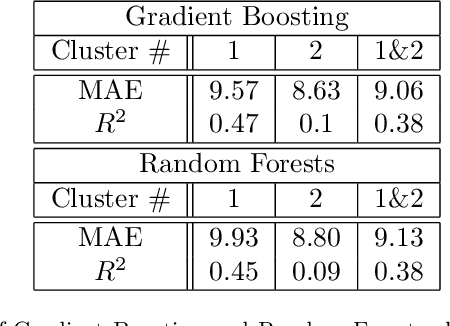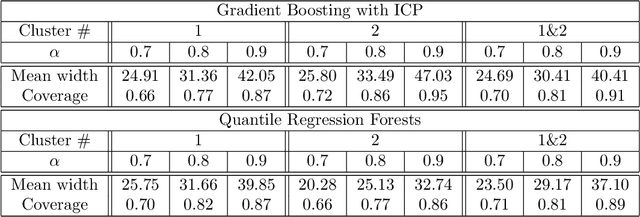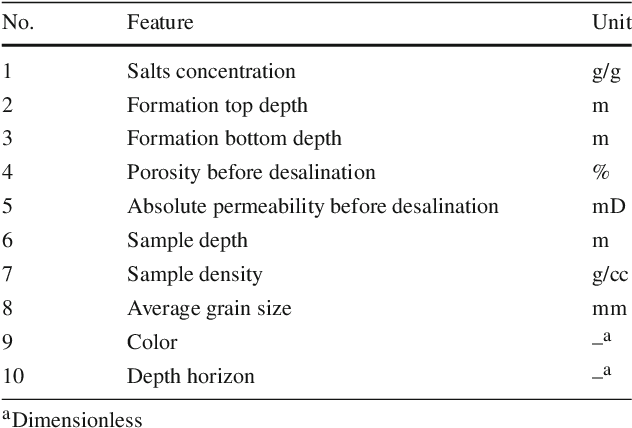Denis Orlov
Machine learning for recovery factor estimation of an oil reservoir: a tool for de-risking at a hydrocarbon asset evaluation
Oct 22, 2020



Abstract:Well known oil recovery factor estimation techniques such as analogy, volumetric calculations, material balance, decline curve analysis, hydrodynamic simulations have certain limitations. Those techniques are time-consuming, require specific data and expert knowledge. Besides, though uncertainty estimation is highly desirable for this problem, the methods above do not include this by default. In this work, we present a data-driven technique for oil recovery factor of hydrocarbon reservoirs using parameters and various representative statistics. We apply advanced machine learning methods using extensive historical worldwide oilfields datasets (more than 2000 oil reservoirs). The data-driven model might be used as a general tool for rapid and completely objective estimation of the oil recovery factor. In addition, it includes the ability to work with partial input data and to estimate the prediction interval of the oil recovery factor. We perform the evaluation in terms of accuracy and prediction intervals coverage for several tree-based machine learning techniques in application to the following two cases: (1) using parameters only related to geometry, geology, transport, storage and fluid properties, (2) using an extended set of parameters including development and production data. For both cases model proved itself to be robust and reliable. We conclude that the proposed data-driven approach overcomes several limitations of the traditional methods and is suitable for rapid, reliable and objective estimation of oil recovery factor for hydrocarbon reservoir.
Prediction of Porosity and Permeability Alteration based on Machine Learning Algorithms
Feb 18, 2019



Abstract:The objective of this work is to study the applicability of various Machine Learning algorithms for prediction of some rock properties which geoscientists usually define due to special lab analysis. We demonstrate that these special properties can be predicted only basing on routine core analysis (RCA) data. To validate the approach core samples from the reservoir with soluble rock matrix components (salts) were tested within 100+ laboratory experiments. The challenge of the experiments was to characterize the rate of salts in cores and alteration of porosity and permeability after reservoir desalination due to drilling mud or water injection. For these three measured characteristics, we developed the relevant predictive models, which were based on the results of RCA and data on coring depth and top and bottom depths of productive horizons. To select the most accurate Machine Learning algorithm a comparative analysis has been performed. It was shown that different algorithms work better in different models. However, two hidden layers Neural network has demonstrated the best predictive ability and generalizability for all three rock characteristics jointly. The other algorithms, such as Support Vector Machine and Linear Regression, also worked well on the dataset, but in particular cases. Overall, the applied approach allows predicting the alteration of porosity and permeability during desalination in porous rocks and also evaluating salt concentration without direct measurements in a laboratory. This work also shows that developed approaches could be applied for prediction of other rock properties (residual brine and oil saturations, relative permeability, capillary pressure, and others), which laboratory measurements are time-consuming and expensive.
Reconstruction of 3D Porous Media From 2D Slices
Jan 29, 2019



Abstract:We propose a novel deep learning architecture for three-dimensional porous media structure reconstruction from two-dimensional slices. A high-level idea is that we fit a distribution on all possible three-dimensional structures of a specific type based on the given dataset of samples. Then, given partial information (central slices) we recover the three-dimensional structure that is built around such slices. Technically, it is implemented as a deep neural network with encoder, generator and discriminator modules. Numerical experiments show that this method gives a good reconstruction in terms of Minkowski functionals.
 Add to Chrome
Add to Chrome Add to Firefox
Add to Firefox Add to Edge
Add to Edge